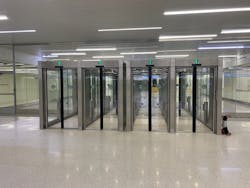MCO Goes Secure with dormakaba Exit Lane Breach Control Technology

Orlando International Airport (MCO) recently improved their security operations with the installation of dormakaba exit lane breach control technology, PIL-M02 16 system, in MCO’s new Terminal C.
The system, which was completed in September, is a one-way corridor featuring three full height doors and two half height gates that ensure passengers are only exiting sterile side onto the non-secured side. There are four lanes for domestic arrivals and four lanes for the international arrivals.
The PIL-M02 16 works via sensors within the lane that track passengers from their entry to their exit ensuring they are walking the correct direction.
dormakaba Americas Business Development Manager Bill Seibert said the technology is replacing guards that used to sit at the gate and puts the technology into the hands of the airport. “There are floor sensors to detect objects left behind, whether accidentally or purposely dropped; or then we also have sensors on the unsecured side for thrown object detection for somebody trying to throw something into the lane,” Seibert said.
Improving day-to-day operations
“It saves the airport money in the long run,” Seibert said. “The technology takes out the human factor; people get distracted, take vacation, get sick; technology is on 24/7 365 days a year. So, it not only saves the airport money, but it also provides the airport with a higher security level.”
HNTB (the designer of record for the project) Senior Program Director JC Arteaga said prior to the system being installed at MCO, Arteaga took airport executives to another airport where the PIL-M02 was already installed to see how it worked.
"Luckily enough at Fort Lauderdale, they were installing a gate and I organized a trip with all the airport executives, and I took them over there so they could see it," Arteaga said. "So, we had meetings with TSA. They were extremely happy with the system, so it was a win-win situation."
Arteaga said the system will update the security operations center at the airport in real time with breach alarm reports.
“If you're trying to go from the public side to the sterile area, it would trap you in these doors. So, it would not allow you to keep going and it would send a signal to central command center and they would send somebody to check you out,” Arteaga said.
"As the doors are opening, there are detectors there that if you try to throw something inside the doors, it would also actually trigger the alarm. So, it's more like a physical security system.," Arteaga said. "It does not rely on people to report any unusual or bad activity or somebody trying to go from landside to airside.”
Installation
Arteaga said the system is fairly easy to install depending on the airport’s current infrastructure. MCO posed a few unique challenges due to the ceiling design.
“You got to just make sure that you have the proper floor recesses, and you have enough room on the ceiling,” Arteaga said. "In Orlando, we could not have something where these doors would have a ceiling because then you would need to bring sprinkler systems. What we did is we created kind of a security screen. …So, it allows water to go through if the fire sprinkler goes off, but at the same time, it offers the security that nobody will be throwing objects over the security doors. And then you create a wall there, in this case, we did a glass wall. So, it's a very secure system.”
The system is available in different widths to meet ADA and can accommodate a 36-inch clear opening or a 44-inch clear opening.
Arteaga said MCO eventually plans to add more PIL-M02 systems.
“When we do phase two, phase two is going to add another 26 gates, it's going to have another hub there, which we call it the north hub and is going to have more of these secured gates," Arteaga said.
Arteaga said he believes it’s always better to rely on technology rather than on people, “because most of the errors that we make are made by people. So having officers that are not even TSA officers, guarding these points create a security threat. So having these systems that are proven to be successful are big enhancements in terms of not only return on investment - because whatever you're spending now, you're going to save and invest that in two years - and you have a more secure system.”
He continued, "the airport executives, the airport director, everybody's very, very, very pleased at the end product.”
About the Author
Christina Marsh
Editor
Christina Marsh (Basken) is a passionate aviation enthusiast and sport pilot with industry knowledge and experience in writing and editing for digital and print publications as well as creative content in photography, videography, and podcasting.
Christina graduated from the University of Wisconsin-Oshkosh with a bachelor’s degree in journalism with a visual emphasis.
